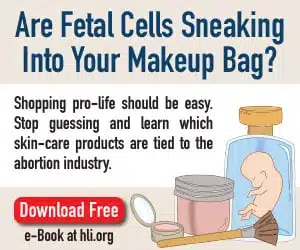Should the Pro-Life Movement Follow a “No Exceptions” or “Pragmatic” Strategy?
Pro-life groups generally emphasize one of two pro-life strategies: the “pragmatic” and the “no exceptions” approaches.
The “Pragmatic” Strategy
“Pragmatic” pro-lifers work for protective laws while taking into consideration local political conditions. In a liberal state, the best one may be able to manage is to pass a parental notification law, work for stricter state regulation of abortion mills, end public abortion funding, or enact humane fetal disposal laws. This strategy recognizes that all abortions are bad, but it may be possible to save some babies.
The abortion industry can only work at peak efficiency if there are absolutely no restrictions on it. Any restriction or regulation of abortion centers by the state will increase costs and decrease profits. In the short run, since most abortionists are motivated by money, this saves the lives of some preborn children.
Another important advantage of “pragmatic” activism is that it is more likely to bring short-term victories that keep pro-lifers motivated. Unfortunately, many have been infected with the “win or else” mentality, so they become lax and uninspired if they cannot immediately see the fruits of their labors. This is why so many new pro-life activists “burn out” so quickly. Very few brave warriors can doggedly carry on for years in the face of a long string of defeats, and without actually seeing measurable victories as the result of their work. Almost everyone needs an occasional victory to boost morale.
So the entire pro-life movement has been heartened and encouraged by the large number of pro-life laws passed in 2011 ― 83, smashing the old record of 34 set in 2005. This encouraging trend has continued with 63 new pro-life laws enacted in 2017, for a total of 401 since January 1, 2011.
Advocates of the “pragmatic” strategy point out that a total ban on abortions in the United States is simply out of the question under the current political climate. Even if a total ban were passed by a state legislature or enacted by popular vote, it would immediately be struck down by the courts. “Pragmatists” assert that it is far more likely that abortion will ultimately be banned by an incremental strategy that takes one small step at a time.
The main disadvantage of the “pragmatic” strategy is subtle but extremely important. Pro-lifers do not want to give the impression that they are simply working with the state to regulate baby-killing. Since pro-lifers claim that all babies are equally valuable, they may appear to be hypocritical to try to save some while apparently abandoning others.
This is a misperception that pro-abortion groups exploit for propaganda purposes. For example, the pro-abortion front group Religious Coalition for Reproductive Choice (RCRC) says, “Opponents of abortion rights walk a fine line within their own movement when they condone any abortion. Based on their own definition, they are guilty of being accessories to ‘murder’ in certain circumstances by accepting rape and incest exceptions.”1
Any intelligent person can see the fallacy of this kind of thinking.
One useful parallel is the “sinking ocean liner” analogy. If a thousand people are in danger of drowning and all you have is a six-person life raft, the right thing to do is to save a handful of people, not turn away because you can’t save everyone. RCRC would have us believe that this means the rescuers approved of the drowning of all of the other people and were therefore accessories to their deaths, which is obviously illogical. RCRC’s propaganda is clearly aimed at goading pro-lifers into formulating and supporting legislation that would immediately be struck down by the courts.
The “Full Protection” Strategy
The second pro-life strategy is the “full protection” approach, which works toward a complete ban on all abortions without compromise. “Full protection” pro-life activists refuse to yield any preborn children to the abortionists’s knife.
The most crucial advantage to this strategy is that it is consistent in holding that every preborn life is equally precious under the law. This steadfast and absolute adherence to the sanctity of life in all cases may indeed lead to ultimate victory.
However, this strategy’s main disadvantage is that its adherents must be willing to suffer a long string of defeats, with few, if any, preborn children being saved under law in the interim.
Another point is central to the debate between “pragmatic” and “full protection” pro-lifers. Even if a Human Life Amendment were passed by Congress and withstood court challenges, illegal abortions would continue by the hundreds of thousands each year. Radical feminists and hard-core pro-abortionists have vowed to set up “underground railroads” and “menstrual extraction” clinics in order to bypass any law that protects preborn children.2
History has also shown us that illegal abortionists operated in plush offices with the full knowledge of police for decades before Roe v. Wade. All over the world police, district attorneys, judges and juries allow “illegal” abortion mills to operate with impunity. What evidence do we have that the situation would be different after abortion is criminalized? In reality, some elements of society have become accustomed to the convenience of legalized abortion, and will strongly resist having it removed.
What Is the Answer?
Both “pragmatic” and “full protection” pro-lifers see every baby as equally precious in the sight of God. Contrary to what the pro-abortionists say, trying to save some babies does not imply abandoning others.
The great encyclical Evangelium Vitae has been called “The Charter of the Pro-Life Movement.” It says:
When it is not possible to overturn or completely abrogate a pro-abortion law, an elected official, whose absolute personal opposition to procured abortion was well known, could licitly support proposals aimed at limiting the harm done by such a law and at lessening its negative consequences at the level of general opinion and public morality. This does not in fact represent an illicit cooperation with an unjust law, but rather a legitimate and proper attempt to limit its evil aspects. [¶73]
Pro-lifers should always advocate for full protection for every preborn child, and never allow language that appears to endorse even a single abortion. Any proposed legislation must be in keeping with the following two principles.3
#1. Equal Treatment of All Babies
Every preborn baby, regardless of health or circumstances surrounding his or her conception, is equally precious in the eyes of God, and therefore is deserving of equal protection. Laws which classify some babies as not as worthy of protection as others (as with fetal deformity, rape and incest exceptions) are intrinsically illicit, and therefore cannot be supported. Parental consent laws are also illicit, because a grandparent may never give permission to execute his or her own grandchild.
By contrast, imperfect legislation does not divide preborn babies into classes, but instead treats all of them equally. Measures that treat all preborn babies with equal dignity include parental notification laws, abortion funding cuts, decent burial requirements, laws that require that only licensed physicians commit abortions, and tighter abortion mill regulations.
In summary, pro-lifers may work for imperfect laws, which treat all preborn babies equally. However, we may never work for illicit laws, which divide preborn babies into classes and judge some to be worthy of protection and others unworthy of such protection.
#2. No “Life” or “Health” Exceptions
Proposed legislation must strictly avoid “life” and “health” exceptions. Pro-lifers must always remember that the standard “health of the mother” exception always means abortion on demand in practice. Pro-abortionists use the World Health Organization definition of “maternal health,” which is “a state of complete physical, mental, and social well being and not merely the absence of disease or infirmity.”
Pro-lifers must not allow pro-abortionists to play the victim and deceive them into supporting even a so-called “life of the mother” exception for abortion. Many high-volume abortionists have claimed that all abortions are medically necessary since, as they falsely allege, they are safer than childbirth.4 Modern medicine has virtually eliminated maternal deaths due to pregnancy, as both Dr. Alan Guttmacher and Dr. Bernard Nathanson attested decades ago.5
In those extremely rare cases when the mother’s life truly is threatened by an underlying medical condition while she is pregnant (such as with cancer of the uterus or ectopic pregnancy), she may undergo a surgical procedure whose purpose is to save her life, even though the preborn child dies as an indirect result of the procedure, but only as long as every reasonable effort has been made to save both mother and child. This course of action is justified under the traditional principle known as “double effect.”
Conclusion: Never Give Up!
In summary, Evangelium Vitae recognizes the distinct limitations that pro-life politicians must account for and allows them to work for and vote for imperfect legislation. It is perfectly clear that it is impermissible for Catholics to work for illicit legislation that treats some preborn babies as unworthy of protection.6
Evangelium Vitae also recognizes that it will be impossible to truly ban abortion by either the “no exceptions” or the “pragmatic” strategy until the family has been strengthened and has regained its proper place as the sanctuary of life in society:
The Church encourages political leaders, starting with those who are Christians, not to give in, but to make those choices which, taking into account what is realistically attainable, will lead to the re-establishment of a just order in the defense and promotion of the value of life….Here it must be noted that it is not enough to remove unjust laws. The underlying causes of attacks on life have to be eliminated, especially by ensuring proper support for families and motherhood. A family policy must be the basis and driving force of all social policies. [¶90]
As long as a society accepts the anti-life mentality, attempting to ban abortion is like trying to empty the ocean with a child’s plastic bucket. Changing the laws may help greatly, but this is not the final answer to the slaughter of preborn children.
The ultimate answer to the killing is to convert the hearts and minds of each person in society. By working to strengthen Church and family, pro-lifers will eventually rise up and gain control of the courts, the legislatures, the media, the professions and the schools.
Only then will every preborn child be safe.
Until this happens, every pro-life activist should memorize 1 Corinthians 15:58, which tells us, “Never give in then, my dear brothers, never admit defeat; keep on working at the Lord’s work always, knowing that, in the Lord, you cannot be laboring in vain.”
Endnotes
[1] “Religious” Coalition for Abortion Rights (RCAR). Booklet titled “Words of Choice.” Washington, D.C., 1991, page 24.
[2] As one of many examples, Frances Kissling, then-President of “Catholics” for [a Free] Choice, said in 1989 during a Supreme Court battle over abortion, “I would like to see a huge underground of activist women learning how to do menstrual extractions and vacuum aspiration abortions, mothers teaching their daughters, sub rosa [covert] classes at campus women’s centers” (Brett Harvey. “The Morning After.” Mother Jones, May 1989, pages 28 to 31 and 43).
[3] This material is drawn from the author’s detailed conversation with the author of Paragraph 73 of Evangelium Vitae, Monsignor Peter Elliott, at Gould House in Sydney, Australia, on July 2, 1998.
[4] Three examples of abortionists claiming that all abortions are medically necessary:
- “Each and every pregnancy threatens a woman’s life. From a strict medical viewpoint, every pregnancy should be aborted” (Abortionist Lise Fortier at the 1980 national convention of the National Abortion Federation [NAF], quoted in Andrew Scholberg. “The Abortionists and Planned Parenthood: Familiar Bedfellows.” International Review of Natural Family Planning, Winter 1980, page 308).
- “A medically necessary abortion is any abortion a woman asks for” (abortionist Jane Hodgson, quoted in Human Life International’s Special Report, Number 83, August 1991, pages 6 and 7).
- “In my medical judgment, every pregnancy that is not wanted by the patient, I feel there is a medical indication to abort a pregnancy where it is not wanted. In good faith, I would recommend on a medical basis, you understand, that, and it would be 100%….I think they are all medically necessary….Occasionally we will advise these women to carry their pregnancy to term, but most of these are medically necessary because I am considering the woman’s physical, mental, emotional and social and welfare and family and environment and all that….I am concerned with the quality of life, not physical existence” (abortionist Jane Hodgson, Transcript, August 3, 1977, at 99-101, McRae v. Califano, 491 F.Supp. 630 [E.D.N.Y. 1980], rev’d sub nom. Harris v. McRae. 100 S. Ct. 2671 [1980]).
[5] “Today it is possible for almost any patient to be brought through pregnancy alive, unless she suffers from a fatal disease such as cancer or leukemia, and if so, abortion would be unlikely to prolong, much less save the life [of the mother]” (Alan Guttmacher. “Abortion Yesterday, Today, and Tomorrow.” The Case for Legalized Abortion Now. Berkeley: Diablo Books, 1967, page 9).
“The situation where the mother’s life is at stake were she to continue a pregnancy is no longer a clinical reality. Given the state of modern medicine, we can now manage any pregnant woman with any medical affliction successfully, to the natural conclusion of the pregnancy: The birth of a healthy child” (Bernard Nathanson, M.D. Written statement to the Idaho House of Representatives’ State Affairs Committee, 16 February 1990. Also quoted in “Exceptions: Abandoning ‘The Least of These My Brethren.'” American Life League booklet, 1991, page 22).
[6] In 2002, the Congregation for the Doctrine of the Faith (CDF) clarified the duties of Catholics regarding abortion legislation in its “Doctrinal Note on Some Questions Regarding the Participation of Catholics in Political Life”:
It must be noted also that a well-formed Christian conscience does not permit one to vote for a political program or an individual law which contradicts the fundamental contents of faith and morals. The Christian faith is an integral unity, and thus it is incoherent to isolate some particular element to the detriment of the whole of Catholic doctrine.…When political activity comes up against moral principles that do not admit of exception, compromise or derogation, the Catholic commitment becomes more evident and laden with responsibility. In the face of fundamental and inalienable ethical demands, Christians must recognize that what is at stake is the essence of the moral law, which concerns the integral good of the human person. This is the case with laws concerning abortion and euthanasia (not to be confused with the decision to forgo extraordinary treatments, which is morally legitimate). Such laws must defend the basic right to life from conception to natural death.
Did you find this useful?
Dr. Brian Clowes has been HLI’s director of research since 1995 and is one of the most accomplished and respected intellectuals in the international pro-life movement. Best known as author of the most exhaustive pro-life informational resource volume The Facts of Life, and for his Pro-Life Basic Training Course, Brian is the author of nine books and over 500 scholarly and popular articles, and has traveled to 70 countries on six continents as a pro-life speaker, educator and trainer.







